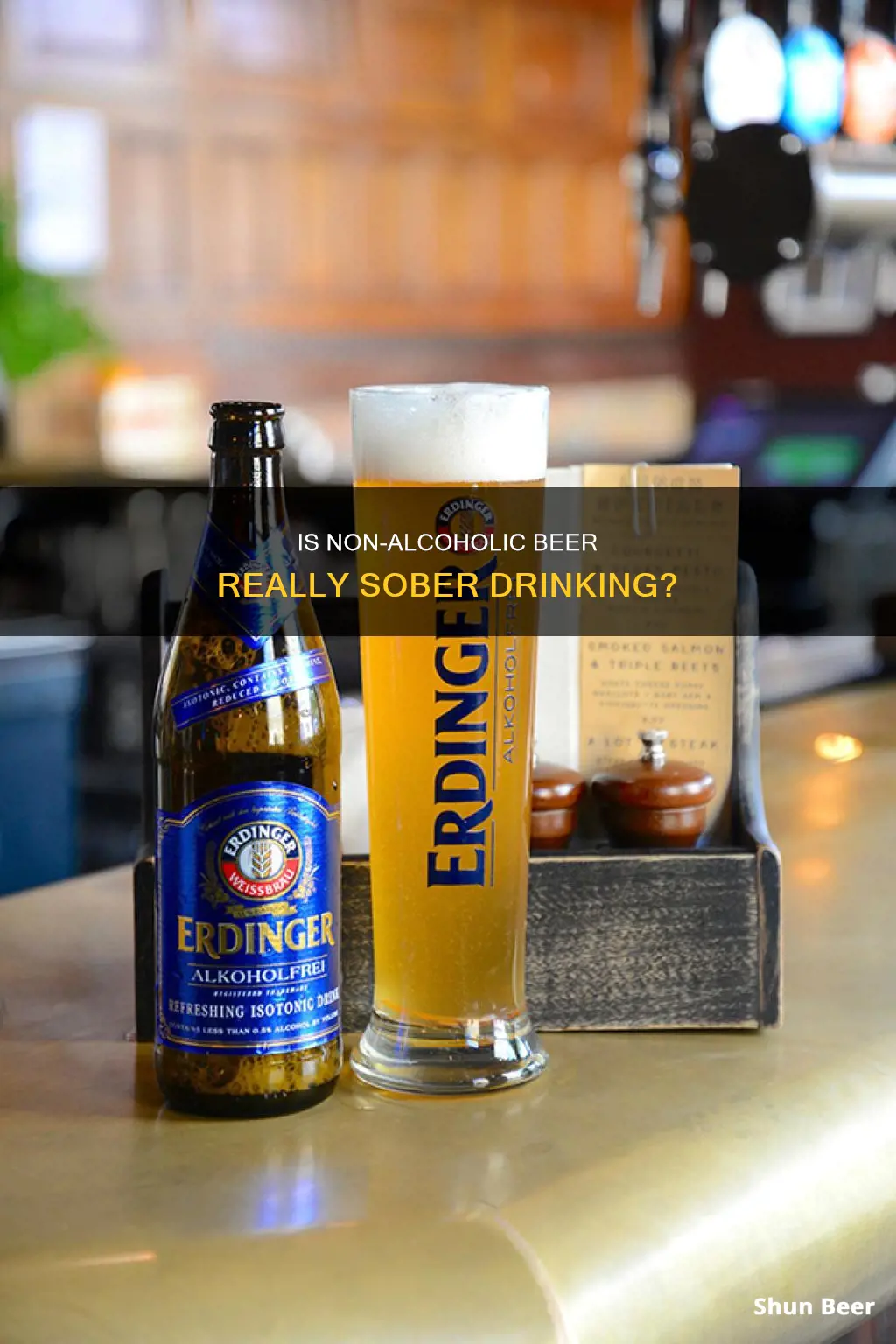
Non-alcoholic beer, or NA beer, has gained popularity as an alternative for those recovering from alcohol addiction or looking to reduce their alcohol intake. While it typically contains minimal or no alcohol, the question of whether consuming it is considered breaking sobriety is a complex one. Sobriety is often defined as abstaining from alcohol entirely, and individuals in recovery may view NA beer as a tool to navigate social situations without compromising their commitment to sobriety. However, the taste, smell, and ritual associated with NA beer can also trigger cravings and emotional associations for those with a history of alcohol addiction, potentially impacting their recovery journey. The decision to consume NA beer during sobriety is a personal one, requiring careful self-reflection and consideration of individual circumstances, triggers, and support systems.
| Characteristics | Values |
|---|---|
| Alcohol Content | Non-alcoholic beer typically contains less than 0.5% alcohol by volume (ABV). However, some products labelled as alcohol-free may contain up to 1% ABV. |
| Taste and Appearance | NA beer is designed to taste and look like traditional beer. |
| Target Audience | NA beer is targeted towards individuals who want to enjoy the taste and social experience of drinking beer without the intoxicating effects of alcohol, including those in recovery from alcohol addiction and those who choose not to consume alcohol for health, religious, or personal reasons. |
| Benefits | NA beer provides a sense of normalcy and inclusivity in social situations where alcohol is present, allowing individuals to participate without compromising their sobriety goals. It also offers a way to enjoy the social and cultural aspects of beer consumption without the significant health risks associated with alcohol. |
| Risks | NA beer may trigger cravings or emotional associations for individuals with a history of alcohol addiction, potentially disrupting their ongoing recovery journey. The taste, ritual, and smell of NA beer can act as psychological triggers, and the small amount of alcohol present may still have physiological effects. |
| Considerations | Individuals considering NA beer should carefully evaluate their personal circumstances, including their reasons for abstaining from alcohol, their definition of sobriety, and their physical and psychological triggers. Consulting with healthcare professionals and support groups is crucial to making an informed decision. |
What You'll Learn
- NA beer may contain a small amount of alcohol, so it's important to check the label
- The decision to drink NA beer during sobriety is usually a personal one
- NA beer can trigger cravings for alcoholic drinks for some people in recovery
- NA beer can be a useful tool for social integration, allowing individuals to avoid alcohol without drawing attention to their abstinence
- Some addiction treatment programs may prohibit the consumption of NA beer, especially in the early stages of recovery

NA beer may contain a small amount of alcohol, so it's important to check the label
Non-alcoholic beer, often referred to as NA beer, has gained popularity as a viable alternative for those who want to enjoy the taste of beer without the intoxicating effects of alcohol. It is designed to taste, look, and resemble traditional beer while containing minimal or no alcohol. However, it's important to remember that NA beer may still contain a small amount of alcohol, so checking the label is crucial.
By definition, non-alcoholic beer typically falls below the legal definition of an alcoholic beverage, usually containing 0.5% alcohol by volume (ABV) or lower. This threshold varies across different countries, with some allowing a higher ABV for products labelled as "non-alcoholic". For instance, the U.S. Alcohol and Tobacco Tax and Trade Bureau (TTB) mandates that "non-alcoholic" beverages must contain less than 0.5% ABV, while the European Union's regulations may differ.
While the amount of alcohol in NA beer is significantly lower than in regular beer, it is essential to acknowledge that it may still be present. Labels on these beverages often indicate the specific alcohol content, ensuring consumers are aware of what they are consuming. This is particularly crucial for individuals in recovery from alcohol addiction or those with specific medical conditions who need to maintain complete abstinence from alcohol.
The decision to consume NA beer during sobriety is a personal one, influenced by individual circumstances and definitions of sobriety. For some, even the minimal alcohol content in NA beer may be a concern, while others may consider it negligible. It is important to carefully consider your reasons for consuming NA beer, how it aligns with your definition of sobriety, and whether you are comfortable with the potential physical and psychological effects.
Additionally, the psychological impact of drinking NA beer cannot be overlooked. For some in recovery, the taste and ritual of drinking beer, even without the alcohol, can act as a trigger, potentially leading to cravings for alcoholic beverages. On the other hand, NA beer can provide a sense of normalcy and inclusion in social settings, allowing individuals to participate in the social ritual of drinking without compromising their sobriety goals.
In conclusion, while NA beer offers a safer alternative to regular beer, it is important to be aware of the small amounts of alcohol that may be present. Checking the label is crucial to making an informed decision, especially for those with specific health considerations or those in recovery from alcohol addiction. The decision to include NA beer in your journey towards sobriety depends on careful self-reflection and consideration of your unique circumstances and goals.
Vegan-Friendly Root Beer: What's the Deal?
You may want to see also

The decision to drink NA beer during sobriety is usually a personal one
The decision to drink non-alcoholic (NA) beer during sobriety is a complex and deeply personal matter that requires careful consideration of various factors. While NA beer offers a way to enjoy the taste and social experience of beer without the intoxicating effects, it is essential to recognize that it still contains trace amounts of alcohol. Here are some key perspectives to consider:
Understanding Sobriety and NA Beer
Sobriety, in the context of alcohol addiction recovery, refers to abstaining from consuming alcoholic beverages to reclaim control over one's life and improve physical and mental well-being. It involves a conscious decision to avoid the detrimental effects of alcohol on health, relationships, and overall quality of life. NA beer, on the other hand, typically contains minimal or no alcohol, falling below the legal definition of an alcoholic beverage. It has gained popularity as an alternative for those in recovery or those choosing not to consume alcohol for health, religious, or personal reasons.
Personal Factors and Triggers
The decision to drink NA beer during sobriety depends on individual circumstances, motivations, and triggers. For some, the taste and ritual of drinking beer, even without alcohol, can act as a trigger, potentially leading to cravings for alcoholic beverages. Others may find that NA beer provides a sense of normalcy and inclusion in social settings, allowing them to participate without compromising their sobriety goals. It is crucial to assess personal goals, triggers, and comfort level with the potential physical and psychological effects of NA beer.
Health Implications
NA beer presents a safer alternative for individuals avoiding alcohol due to its health implications. However, it is important to be aware of its calorie content and potential additives or sugars, which could affect dietary goals. Additionally, for those with specific medical conditions, such as liver disease, complete abstinence from all forms of alcohol, including NA beer, may be necessary.
Perspectives from the Recovery Community
The recovery community, including sobriety coaches and recovering alcoholics, holds diverse viewpoints on NA beer. Some coaches advocate for complete abstinence from any beverage resembling alcohol, while others recognize NA beer as a potential harm-reduction tool when consumed responsibly. Recovering alcoholics may find NA beer helpful in feeling included during social occasions without risking their sobriety, while others prefer to avoid any reminders of their past struggles.
Seeking Professional Guidance
Given the subjective nature of the decision, it is advisable to seek professional guidance from addiction specialists, therapists, or counselors. They can provide tailored advice and help individuals explore the potential effects of consuming NA beer on their sobriety journey. Recognizing the importance of professional expertise empowers individuals to make choices that align with their unique recovery process and personal preferences.
In conclusion, the decision to drink NA beer during sobriety is indeed a personal one, and it requires a thorough understanding of one's circumstances, triggers, and goals. By evaluating these factors and seeking support, individuals can make informed choices that support their long-term well-being and recovery.
Beer and Weight Gain: Is There a Link?
You may want to see also

NA beer can trigger cravings for alcoholic drinks for some people in recovery
Non-alcoholic (NA) beer has gained popularity as an alternative for those in recovery from alcohol addiction. While it contains minimal or no alcohol, it can still trigger cravings and emotional associations for some individuals with a history of alcohol addiction. The smell of NA beer, in particular, may evoke triggers and cravings, as it closely resembles that of regular beer.
For individuals in recovery, NA beer can be a double-edged sword. On the one hand, it can provide a sense of normalcy and inclusivity in social situations where alcohol is present, allowing them to participate without feeling left out. On the other hand, the very presence of alcohol in NA beer, no matter how minimal, can be a trigger for some people in recovery. The act of consuming a beverage that resembles beer in taste and smell can evoke powerful cravings and reminders of past drinking experiences, potentially jeopardizing their sobriety.
Research supports this concern, indicating that the smell of NA beer may be enough to trigger cravings and a subsequent relapse among certain people with alcohol use disorder. A study conducted by California scientists found that the smell of beer alone increased levels of dopamine, a brain chemical associated with feelings of elation and pleasure, in laboratory rats. While further research is needed to confirm this effect in humans, it underscores the potential risk of NA beer triggering cravings in those struggling with alcohol addiction.
Additionally, it is important to note that NA beer may still contain small amounts of alcohol. Labels often indicate specific alcohol content, but research suggests that many NA beers contain more alcohol than advertised. This discrepancy can be particularly dangerous for individuals in recovery, as even trace amounts of alcohol can disrupt their sobriety.
In conclusion, while NA beer can be a helpful tool for some in recovery, it is crucial to recognize that it may also trigger cravings and pose risks for relapse. Each person in recovery must consider their unique circumstances, triggers, and goals when deciding whether NA beer aligns with their definition of sobriety. Seeking professional guidance and support from healthcare professionals or recovery groups can aid in making an informed decision that supports long-term recovery and well-being.
Beer Batters: How Do They Work?
You may want to see also

NA beer can be a useful tool for social integration, allowing individuals to avoid alcohol without drawing attention to their abstinence
NA beer, or non-alcoholic beer, is a beverage designed to taste and look like traditional beer but contains minimal or no alcohol. It has gained popularity as an alternative for those who want to enjoy the taste and social experience of drinking beer without the intoxicating effects of alcohol. This includes individuals in recovery from alcohol addiction and those who choose not to consume alcohol for health, religious, or personal reasons.
NA beer can be a valuable tool for social integration, allowing people to avoid alcohol without drawing attention to their abstinence. It enables individuals to participate in social gatherings and rituals without feeling left out or pressured to consume alcoholic drinks. This sense of normalcy and inclusivity is particularly beneficial for those in recovery, as it helps them navigate social situations where alcohol is present without compromising their sobriety goals.
However, it is important to recognize that NA beer may still contain trace amounts of alcohol, and the decision to consume it during recovery is a personal one. For some, even the minimal alcohol content in NA beer may be enough to necessitate avoidance. The taste, ritual, and social cues associated with NA beer can act as triggers, potentially leading to cravings for alcoholic beverages. Additionally, the smell of beer may serve as a relapse trigger for individuals with a history of alcohol addiction.
The effectiveness of NA beer as a tool for social integration also depends on the perception of peers, especially within support groups or among others in recovery. Some may view it as a slippery slope, while others may see it as a personal decision that does not impact sobriety. Ultimately, the decision to include NA beer in one's recovery journey depends on careful self-reflection and consideration of individual circumstances, motivations, and triggers.
While NA beer can provide a sense of normalcy and inclusion, it is crucial to prioritize well-being and recovery. If NA beer introduces doubts, anxieties, or triggers that outweigh the perceived benefits, alternative drink options should be chosen.
Beer and Blood Pressure: Safe to Mix?
You may want to see also

Some addiction treatment programs may prohibit the consumption of NA beer, especially in the early stages of recovery
The decision to consume NA beer is a highly personal one, and individuals in recovery must weigh the pros and cons based on their unique circumstances and triggers. While NA beer can be a helpful tool for those in recovery, providing a sense of normalcy and inclusivity in social situations, it may also pose certain risks.
The consensus among experts and individuals in recovery is that each person must evaluate their own physical and emotional triggers and make an informed decision. For some, the benefits of NA beer may outweigh the risks, while for others, the potential dangers may be too significant to ignore. It is crucial to consult with healthcare professionals, support groups, and recovery coaches to determine the best course of action for one's unique journey to sobriety.
Ultimately, the decision to consume NA beer during recovery depends on individual circumstances and one's ability to assess and manage their triggers effectively.
Drinking Beer on Swiss Streets: What's Allowed?
You may want to see also
Frequently asked questions
NA beer, or non-alcoholic beer, is a beverage that is designed to taste and look like traditional beer but contains very little or no alcohol.
There is no definitive answer to this question. It depends on individual circumstances and the specific requirements of any court-mandated sobriety or addiction treatment programs. It is important to note that NA beer does still contain a small amount of alcohol.
The taste and ritual of drinking NA beer can act as a trigger, potentially leading to cravings for alcoholic beverages. Additionally, the smell of NA beer may serve as a relapse trigger.
NA beer can provide a sense of normalcy and inclusion in social settings where alcohol is present. It allows individuals to participate in the social ritual of drinking without compromising their sobriety goals and can ease social pressure and questions about not drinking.
Deciding whether to drink NA beer during sobriety involves careful self-reflection. It is important to consider your reasons for wanting to drink NA beer, your personal definition of sobriety, and whether you are aware of and comfortable with the potential physical and psychological effects. Consulting with a support network of trusted friends, family, or members of a support group can also provide valuable perspectives.







